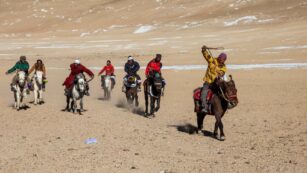
In a world where the traditional nine-to-five lifestyle is often seen as the only path, the nomadic lifestyle emerges as a compelling alternative. Defined by movement and change, this way of life eschews the stationary for a journey filled with constant exploration and freedom. It’s not just about travel; it’s about embracing a lifestyle that values experiences over possessions, and adaptability over conformity.
Nomadic Lifestyle
Nomadic lifestyle involves living a life in motion, often moving from location to location without a permanent home. It embraces change and the exploration of different environments and cultures.
Historical Context of Nomadism
 Nomadism has ancient roots traced back to hunter-gatherer communities that moved periodically to access new resources and optimize their survival chances. Early nomadic groups, like the Bedouins of the Middle East and the Mongols of Central Asia, relied heavily on livestock, migrating to sustain their herds and their way of life. Over the centuries, these movements shaped not only survival strategies but also the cultural landscapes, economies, and social structures of various peoples around the world.
Nomadism has ancient roots traced back to hunter-gatherer communities that moved periodically to access new resources and optimize their survival chances. Early nomadic groups, like the Bedouins of the Middle East and the Mongols of Central Asia, relied heavily on livestock, migrating to sustain their herds and their way of life. Over the centuries, these movements shaped not only survival strategies but also the cultural landscapes, economies, and social structures of various peoples around the world.
This traditional form of nomadism has evolved yet persists in some cultures today, maintaining its relevance in modern societies. The principles of mobility and flexibility remain central to the nomadic lifestyle, demonstrating its lasting appeal and adaptability through time. As societies developed technological solutions, nomadism adapted, particularly with the advent of the digital age, allowing people to maintain mobility without sacrificing connectivity or productivity.
Characteristics of a Nomadic Lifestyle
Nomadic lifestyles revolve around moving from one location to another rather than maintaining a fixed residence. This mobility fosters unique travel patterns and sociocultural impacts that distinguish nomads from more sedentary populations.
Mobility and Travel Patterns
Nomads often exhibit distinct travel patterns, characterized by their flexibility and adaptability. They typically move in cycles or seasons, following optimal resource availability or favorable climates. For instance, pastoral nomads in the Sahel region migrate following rain patterns to find fresh pastures for their livestock. Similarly, modern digital nomads might select destinations based on connectivity, climate, or cultural opportunities, adhering to visa regulations and seasonal advantages.
Sociocultural Impacts
The sociocultural impacts of a nomadic lifestyle are profound, influencing social structures, cultural exchanges, and even personal identities. Nomadic communities, be they traditional pastoral groups or contemporary global travelers, tend to develop strong bonds within their moving groups but remain somewhat detached from local communities.
Their frequent interactions with diverse cultures propel a unique cross-cultural exchange, enriching their understanding and often passing new knowledge between groups. Furthermore, the resilience required by constant movement fosters a unique set of adaptive skills and a broad worldview among nomads. This lifestyle promotes less materialistic views and a profound appreciation for experiences over possessions.
Modern Nomadic Lifestyles
Types of Modern Nomads
-
 Digital Nomads: They rely on internet connectivity to perform their jobs from various global locations, including cafes, co-working spaces, and short-term rental homes. Examples include freelance graphic designers, writers, and software developers.
Digital Nomads: They rely on internet connectivity to perform their jobs from various global locations, including cafes, co-working spaces, and short-term rental homes. Examples include freelance graphic designers, writers, and software developers. -
Van Lifers: Individuals or couples transform vans into mini-homes, traveling and living on the road. Typically, they seek adventure in nature, explore different cities, and embrace minimalistic living.
-
Expatriates: Often relocating due to work commitments, expatriates temporarily reside in foreign countries, immersing themselves in new cultures while retaining job-related responsibilities.
-
Flexibility: Modern nomads enjoy scheduling freedom, choosing when and where to work.
-
Minimalism: They often embrace a minimalist lifestyle, owning fewer possessions to stay mobile.
-
Cultural Exchange: Living in various locations fosters engagement with diverse cultures, enhancing personal growth and understanding.
Challenges of Being Nomadic
Social Challenges
Navigating relationships ranks high among the social challenges nomads face. Maintaining long-term relationships, both personal and professional, becomes complex when one’s location frequently changes. Nomads often report feelings of isolation and disconnection from communities, leading to potential loneliness. Adaptation to new social environments, if moving occurs regularly, might strain emotional resilience.
Logistical Challenges
Traveling from one place to another introduces logistical complexities. Arranging consistent and reliable internet connections is paramount for digital nomads, whose work depends on online access. Navigating visas and local legislation can become arduous, particularly in regions with strict immigration policies. Furthermore, healthcare access varies widely between countries, complicating medical care, especially for those with ongoing health conditions.
